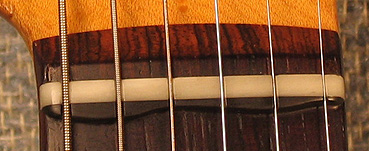Getting
To "Tuned"
Or
What's Up With the Intonated Nut?
There are many authoritative explanations on the web these days to explain the physics of why an intonated nut is helpful in making your instrument more tunable. The short version is that the issue underlying the discussion is that if a guitar with a standard nut is intonated at the bridge alone, as is the traditional norm, even if an experienced luthier is using even the most accurate of strobe tuners, the result will be a tendency for the fretted notes to run increasingly on the sharper side of the intended pitch as they get closer to the nut, especially within the first five frets area. Since many chords can commonly cover a 3-4 fret range, you can sense why this is a problem. Sometimes the string does slip or the bridge resettles, but the deeper problem is that without nut correction, it's nearly impossible to attempt to tune a guitar and have even the most common chords all sound agreeably in tune. You can wind up tuning in never ending circles and it's not your fault.
Suffice it to say, that whether you choose to remain in keeping with either the traditional temperament standards or one of the many possible variations, an intonated nut will allow you to spend less time retuning and more time playing. You will also often be rewarded with longer sustain, more defined and powerful low end and richer textures in chords, especially within the area of the first five frets. You may also be rewarded with a more appreciative listening audience that doesn't have to sit through awkward retuning breaks and bad jokes.
Kudos to Buzz for shedding a bright light on the issue, although the first meaningful attempts I'm aware of date back to the 60's with the MicroNut on the Microfrets guitar. I believe Buzz's addition was to try to minimize the inharmonic intervals by designing a new temperament altogether, to go along with a formulated linear offset for the nut so as to mimic the principles behind stretch tuning for a piano. Personally, I was finally forced to deal with the problem when I was getting noticeably more than usual sustain out of some new designs that made some of these traditionally inharmonic intervals more noticeable than I was happy with. At the same time, I was faced with trying to solve a worse than normal tunability quirk of New Standard Tuning while doing a setup and I quickly realized that there was not going to be a satisfactory one size fits all solution.
Fingerboards
and scale lengths vary more than you might think, even from the same manufacturer.
Add to that the elements of different fret sizes, varying string tensions
due to gauge, wind, materials and tuning as well as different preferences
in setup. One must also take into account the adjustability of the bridge
at the other end. Some bridges can be tuned with precision while others allow
little or no adjustment and one can only seek the best compromise possible,
based on player experience. It is easy to see that each instrument must be
broadly evaluated and have the degree of each individual strings' nut offset
carefully calculated bearing in mind all these considerations to achieve the
best results possible. It's just inevitable that every guitar should require
its' own unique pattern or fingerprint, if you will, in the offset.
The
attempt to resolve this at the guitar manufacturers level is made challenging
as they usually have no way of knowing who's going to actually be playing
it. Thus they have no idea of whether the player exercises a light or heavy
touch, what gauge of strings they prefer and in which tuning it will most
often be used in. Attempts to second-guess these things for the mass market
is often preferable to doing nothing at all, but it really should be refined
with knowledge of the specific players preferences.
